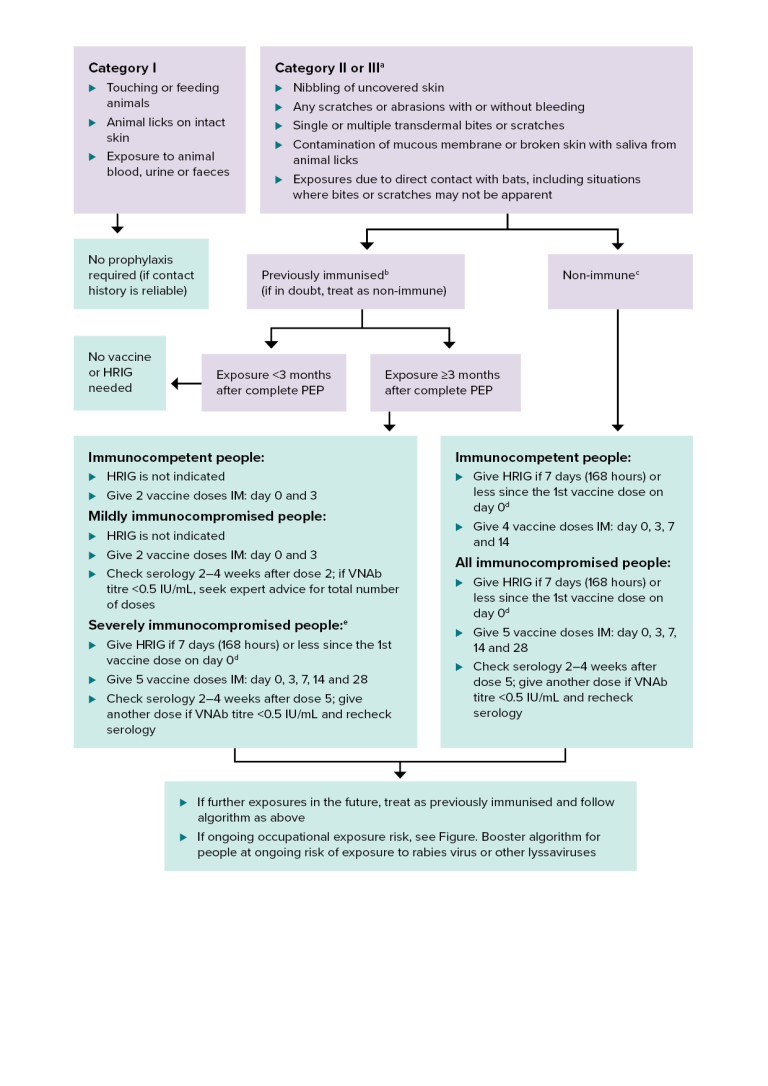Figure. Rabies post-exposure prophylaxis (PEP): bat exposures
This algorithm gives guidance on post-exposure prophylaxis (PEP) after potential exposure to lyssaviruses from bats in Australia or overseas.
Figure. Rabies post-exposure prophylaxis (PEP): bat exposures

HRIG = human rabies immunoglobulin; IM = intramuscularly; PEP = post-exposure prophylaxis; VNAb = virus neutralising antibody
a Includes direct contact with bats in situations where the exposure may be difficult to categorise because a person does not know or cannot communicate if or how an exposure to a bat has occurred. Some bats have small teeth and claws, so bites or scratches may not be apparent.
b Previously immunised — documentation of at least 2 doses of pre- or post-exposure prophylaxis rabies vaccine, regardless of the time since the last dose was given. It may be either a completed primary pre-exposure course or a post-exposure course. It includes people who had subsequent boosters, or who have documented rabies VNAb titres ≥0.5 IU/mL. For more details, see Incomplete pre-exposure prophylaxis schedule.
c Non-immune — person who has never received pre- or post-exposure rabies vaccine, or has had an incomplete (<2 doses) primary vaccination course.
d Give HRIG in a different limb to the vaccine.
e For defining the level of immunocompromise, see Definitions and Table. Types of medical conditions and immunosuppressive therapy and associated levels of immunocompromise in Vaccination for people who are immunocompromised.
This algorithm gives guidance on post-exposure prophylaxis after potential exposure to lyssaviruses from bats in Australia or overseas.
There are 3 categories of exposure to lyssaviruses from bats:
- Category 1. Touching or feeding animals, animal licks on intact skin, or exposure to animal blood, urine or faeces.
- Category 2 or 3. (see note a) Animal nibbling of uncovered skin; any scratches or abrasions with or without bleeding; single or multiple transdermal bites or scratches; contamination of mucous membrane or broken skin with saliva from animal licks; or exposures due to direct contact with bats, including situations where bites or scratches may not be apparent.
Category 1 does not require any prophylaxis if the contact history is reliable.
Category 2 or 3 exposure in people who have been previously immunised (see note b; if in doubt, treat as non-immune). If exposure is <3 months after complete post-exposure prophylaxis, no vaccine or HRIG is needed. If exposure is 3 months or longer after complete post-exposure prophylaxis, vaccination is required. For immunocompetent people, HRIG is not indicated; give 2 vaccine doses intramuscularly on days 0 and 3. For mildly immunocompromised people, HRIG is not indicated; give 2 vaccine doses intramuscularly on days 0 and 3; check serology 2–4 weeks after dose 2; if VNAb titre is <0.5 IU/mL, seek expert advice for total number of doses. For severely immunocompromised people (see note e), give HRIG if 7 days (168 hours) or less since the 1st vaccine dose on day 0 (see note d); give 5 vaccine doses intramuscularly on days 0, 3, 7, 14 and 28; check serology 2–4 weeks after dose 5; give another dose if VNAb titre is <0.5 IU/mL and recheck serology.
Category 2 or 3 exposure in a non-immune person (see note c). For immunocompetent people, give HRIG if 7 days (168 hours) or less since the 1st vaccine dose on day 0 (see note d); give 4 vaccine doses intramuscularly on days 0, 3, 7 and 14. For all immunocompromised people, give HRIG if 7 days (168 hours) or less since the 1st vaccine dose on day 0 (see note d); give 5 vaccine doses intramuscularly on days 0, 3, 7, 14 and 28; check serology 2–4 weeks after dose 5; give another dose if VNAb titre is <0.5 IU/mL and recheck serology.
For all exposure groups, if there are further exposures in the future, treat as previously immunised and follow the algorithm as above. If there is ongoing occupational exposure risk, see Figure. Booster algorithm for people at ongoing risk of exposure to rabies virus or other lyssaviruses.
These files may not be suitable for users of assistive technology.

